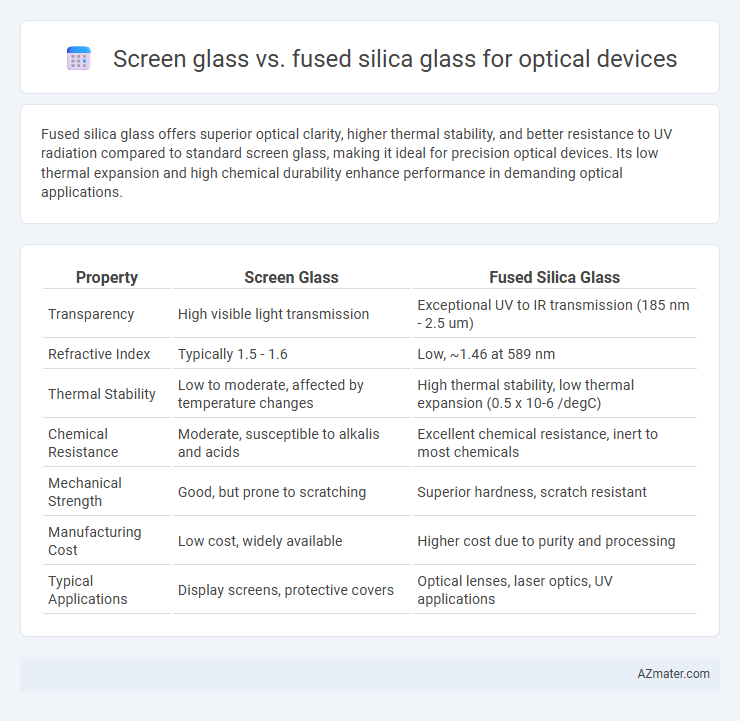Fused silica glass offers superior optical clarity, higher thermal stability, and better resistance to UV radiation compared to standard screen glass, making it ideal for precision optical devices. Its low thermal expansion and high chemical durability enhance performance in demanding optical applications.
Table of Comparison
| Property | Screen Glass | Fused Silica Glass |
|---|---|---|
| Transparency | High visible light transmission | Exceptional UV to IR transmission (185 nm - 2.5 um) |
| Refractive Index | Typically 1.5 - 1.6 | Low, ~1.46 at 589 nm |
| Thermal Stability | Low to moderate, affected by temperature changes | High thermal stability, low thermal expansion (0.5 x 10-6 /degC) |
| Chemical Resistance | Moderate, susceptible to alkalis and acids | Excellent chemical resistance, inert to most chemicals |
| Mechanical Strength | Good, but prone to scratching | Superior hardness, scratch resistant |
| Manufacturing Cost | Low cost, widely available | Higher cost due to purity and processing |
| Typical Applications | Display screens, protective covers | Optical lenses, laser optics, UV applications |
Introduction to Optical Glass Materials
Screen glass and fused silica glass serve distinct roles in optical devices due to their differing optical properties and chemical compositions. Screen glass, typically composed of soda-lime or borosilicate glass, offers cost-effective transparency and moderate thermal stability, making it suitable for display screens and general optics. Fused silica glass, made from high-purity silicon dioxide, exhibits superior ultraviolet transmission, exceptional thermal resistance, and low thermal expansion, ideal for high-performance lenses, laser systems, and precision optical components.
Overview of Screen Glass
Screen glass is a specialized type of glass commonly used in optical devices for its excellent mechanical strength and high optical clarity. It offers a smooth surface finish with low reflectance and high transmission rates, making it ideal for touch screens and display panels. Compared to fused silica glass, screen glass typically provides enhanced durability and cost-effectiveness while maintaining adequate optical performance for various applications.
Overview of Fused Silica Glass
Fused silica glass is a high-purity, non-crystalline form of silicon dioxide known for its exceptional optical clarity, low thermal expansion, and excellent resistance to thermal shock and UV radiation. It offers superior transmission across a broad wavelength range, from ultraviolet to infrared, making it ideal for precision optical devices and high-performance lenses. Compared to standard screen glass, fused silica provides enhanced durability and stability in harsh environmental conditions, ensuring consistent optical performance.
Key Material Properties Comparison
Screen glass offers high transparency and moderate thermal stability, making it suitable for general optical displays but less resistant to thermal shock than fused silica. Fused silica glass excels in exceptional thermal resistance, low thermal expansion coefficient (approximately 0.5 x 10^-6 /degC), and superior optical clarity over a wide UV to IR spectrum, ideal for precision optical devices. Its high chemical durability and low refractive index variation ensure minimal optical distortion in laser applications and high-performance lenses.
Optical Performance: Clarity and Transmission
Fused silica glass delivers superior optical performance with exceptional clarity and high transmission across a broad wavelength range from ultraviolet to infrared, making it ideal for precision optical devices. Screen glass typically exhibits lower clarity and limited transmission due to impurities and manufacturing processes, which can introduce scattering and absorption. The high purity and uniformity of fused silica minimize optical distortion and maximize light throughput, enhancing overall device efficiency.
Thermal and Mechanical Stability
Screen glass exhibits moderate thermal stability with a lower coefficient of thermal expansion around 9 x 10^-6 /degC, which limits its performance under rapid temperature changes, whereas fused silica glass offers superior thermal stability due to its ultra-low thermal expansion coefficient of approximately 0.5 x 10^-6 /degC, ideal for precision optical devices exposed to fluctuating temperatures. Mechanically, fused silica surpasses screen glass with higher hardness and strength, providing better resistance to scratches and mechanical stress, essential for maintaining optical clarity and alignment in high-performance applications. The exceptional combination of low thermal expansion and high mechanical durability in fused silica glass ensures minimal distortion and reliable operation in demanding optical environments.
Resistance to Environmental Factors
Screen glass offers moderate resistance to environmental factors such as humidity and temperature fluctuations, but it can degrade over time under prolonged exposure to UV light and chemical contaminants. Fused silica glass exhibits superior durability with exceptional resistance to thermal shock, chemical corrosion, and UV radiation, making it ideal for demanding optical applications. The inherent chemical purity and low thermal expansion coefficient of fused silica ensure long-term stability and minimal degradation in harsh environmental conditions.
Cost and Manufacturing Considerations
Screen glass typically offers a lower initial cost compared to fused silica glass, making it attractive for applications with budget constraints. Manufacturing fused silica glass involves higher precision and energy-intensive processes, resulting in increased production expenses but superior optical clarity and thermal stability. Choosing between the two depends on balancing cost-efficiency against performance requirements and manufacturing complexity in optical device production.
Suitability for High-Precision Optical Devices
Screen glass offers moderate clarity and durability but falls short in transmission efficiency and thermal stability critical for high-precision optical devices. Fused silica glass provides superior optical transparency across ultraviolet to infrared wavelengths and exhibits exceptional thermal and chemical stability, making it ideal for high-precision lenses, mirrors, and optical components. Its low thermal expansion and high damage threshold ensure consistent performance in demanding optical applications where precision and reliability are paramount.
Conclusion: Choosing the Right Glass for Optical Applications
For optical devices, fused silica glass offers superior optical clarity, higher thermal stability, and better UV transmission compared to screen glass, making it ideal for precision applications requiring durability and minimal light distortion. Screen glass is typically less expensive but has lower optical performance and is more prone to scratches and thermal stress. Selecting fused silica glass ensures enhanced device longevity and performance in demanding environments, whereas screen glass suits cost-sensitive, less critical applications.

Infographic: Screen glass vs Fused silica glass for Optical device
 azmater.com
azmater.com